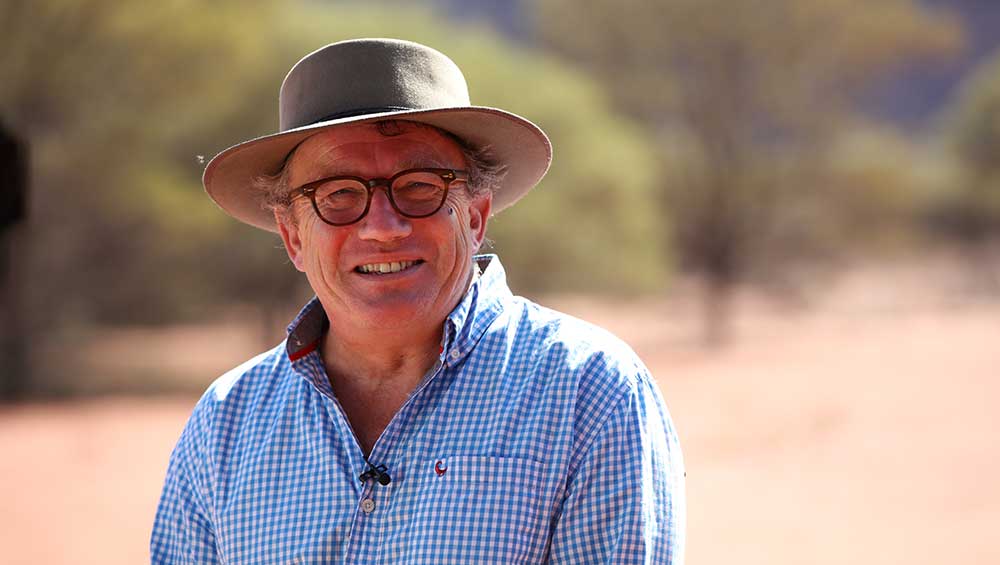
Bruce Munro. Photo courtesy Bruce Munro Studio.
by DAVID TRIGG
The spectacular, large-scale light works of Bruce Munro (b1959, London) elicit a wide range of reactions, from wonder and surprise, to joy, curiosity and sometimes even tears. His immersive, site-specific installations have lit up locations including the Central Australian Desert, Californian vineyards, art museums, cathedrals and country houses. Inspired by moments of shared human experience, his practice is an enquiry into the sensory possibilities of light and the emotional impact it can have on viewers.
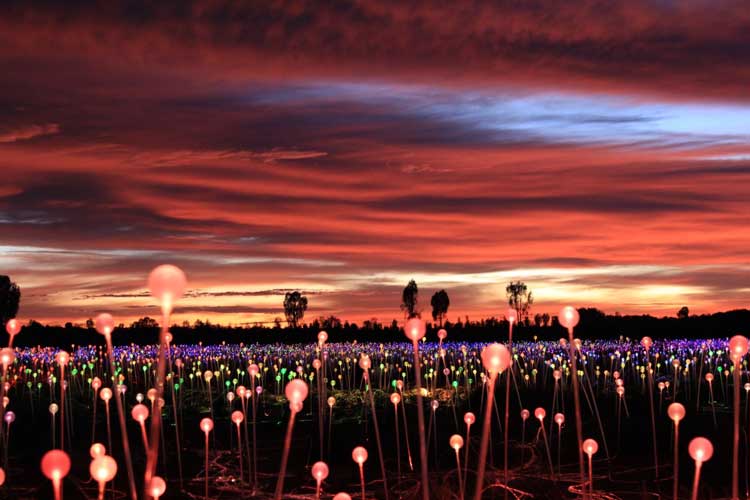
Bruce Munro. Field of Light, Uluru, Australia, 2016. Mild steel, acrylic stems, glass spheres, fibre optics, light source, 49,000 sq m. Photo: Serena Munro.
After studying art at Bristol Polytechnic in the late 1970s, Munro pursued a successful career in commercial lighting before returning to art at the turn of the millennium. This colourful trajectory is the subject of a new monograph, Light Field: The Art of Bruce Munro by Fiona Gruber, which tells the story of how the artist came to create his largest and best-known work, Field of Light (2016), a permanent installation at Uluru/Ayers Rock in Australia’s Northern Territory. “I was dreaming about doing Field of Light for years,” Munro says of the sweeping, solar-powered carpet of 52,000 glowing and shimmering stemmed spheres that stretch across the desert floor and slowly shift colour, from ochre to deep violet, to blue and soft white. Ambitious in scale and vision, it was a labour of love that took 24 years to come to fruition.
More than seven football fields in size, Field of Light was conceived by Munro during a visit to Uluru in 1992 with his fiancee, now wife, Serena. He had travelled to Sydney in 1984, originally for six months but staying for eight years. “When I first arrived there, I had this extraordinary feeling that I’d come home,” he says. “Even though that was my first visit, it was almost like I’d somehow lived there before. It felt natural and I immediately loved it.” Like many, he was drawn to Uluru to witness one of the world’s largest rock formations, but found a place of great cultural and spiritual significance, especially for Indigenous Australians. His visit to the sacred site moved him profoundly and he describes experiencing a palpable sense of joy and serenity there. “I felt so alive at Uluru, energy seemed to be coming out of the ground, or in the air; it was extraordinary, and I began to think about how I could make a piece of art to express what I was experiencing. Luckily, I was mucking around with lights at the time. It was just serendipity.”
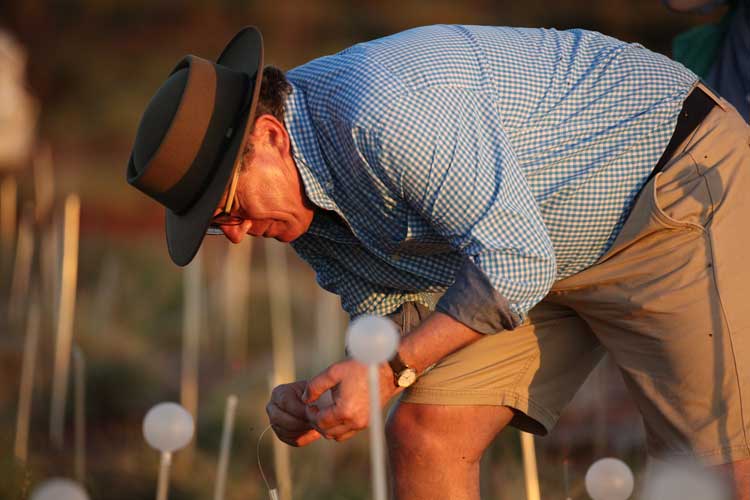
Bruce Munro. Field of Light, Uluru, Australia, 2016. Mild steel, acrylic stems, glass spheres, fibre optics, light source, 49,000 sq metres. Photo: Serena Munro.
While living in Australia, Munro worked as a bricklayer, aerobics instructor and illustrator before starting a lighting company, Neo Neon. His vision for Uluru was to create a vast field of light stems that, like dormant seeds in a dry desert, would quietly wait for darkness to fall before emerging from the ground with a radiant and variegated display. “Deserts have many incongruities. They are infertile, barren places until it rains and then they bloom like a veritable Eden,” he wrote in his sketchbook at the time. It was to be a theatrical spectacle, a kind of nocturnal dance of light that evoked a blossoming desert. “It took a while, but I’d had such a powerful experience in Australia that I just had to make sure it happened,” he says.
“I was very sad when we left Australia in 1992. I felt that I’d left something very important behind,” Munro says of the decision to return to the UK to care for his ailing parents. It would be 12 years before he found himself in a position to create the first open-air iteration of Field of Light. In the intervening years, he ran a tile business and worked for Grand Designs presenter Kevin McCloud’s design studio, McCloud Lighting. In 1996, he established his own bespoke lighting company, working for a range of prestigious clients, among them London theatres, museums, hotels and department stores such as Harrods and Harvey Nichols. “While I was doing that, I was constantly telling anybody who would listen about this large-scale light project that I had to do at all costs. I’m sure many people thought I was a bit cracked – I was obsessed!”
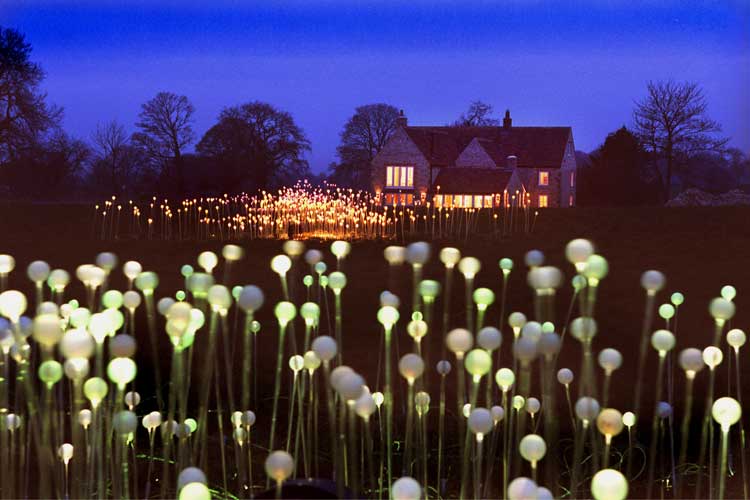
Bruce Munro. Field of Light, Long Knoll, 2004. Copyright © 2022 Bruce Munro. All rights reserved.
In 2003, he and his family moved to a 16th-century farmhouse in Kilmington, rural Wiltshire. With almost five hectares (12 acres) of land, he was finally able to experiment with prototypes for the large outdoor installation. It was during the 2004 Christmas season that Munro successfully installed Field of Light in the meadow behind his farmhouse. The illuminated orbs, glowing on slender stems, 10,000 of which had been used for a Harvey Nichols window display, were increased to 15,000 and arranged in 30 concentric circles, each containing 500 stems. A programmable LED projector at the centre of each circle provided the light source for the stems, which were connected with more than 64km (40 miles) of fibre optic cable. Munro had experimented with colour-changing light stems earlier in the year, wrapping them around the base of trees in the Pirelli garden at London’s V&A as part of Brilliant, an exhibition about the intersection of art, design and light. Now, he was able to increase the scale of his vision.
“I felt a sense of joy and relief that I’d stuck to my guns,” says Munro, thinking back to the moment he flicked the switch and saw Field of Light burst into colour for the first time. “I was able to do it because I’d extended the mortgage on our house.” In fact, he had managed to rack up £50,000 of debt from the installation due to miscalculating his labour costs. “Threading fibre optic cable is very time-consuming. My wife wanted to know who was funding the project and she wasn’t best pleased when I told her. But I’d spent 10 years with this idea buzzing away in my brain. Thankfully, she’s forgiven me now and Field of Light has since proved its worth.”
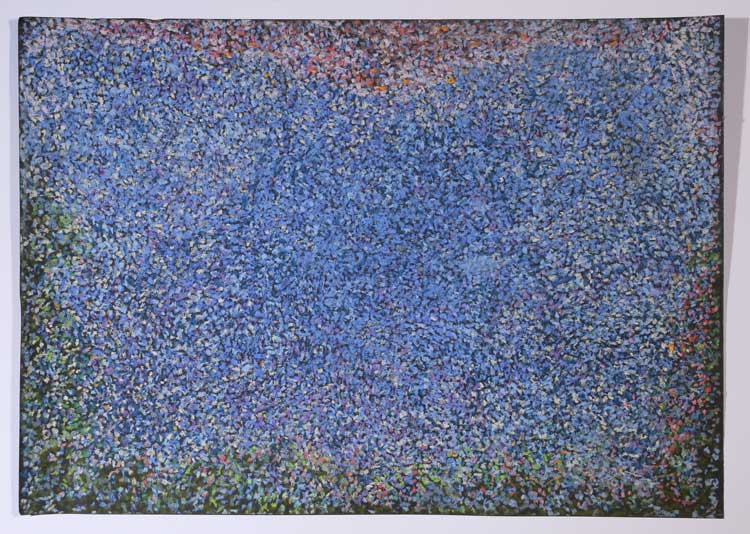
Bruce Munro. Uluru 1992. Pastel on paper, 42 x 59.4 cm. Bruce Munro Private Collection.
The light installation was not limited to Munro’s field. Indeed, it could be seen and appreciated from several vantage points in the nearby countryside and attracted many visitors. “One local lady had come to see the installation several times and asked if she could bring a friend; she wasn’t very steady on her feet, so they wanted to drive up to the edge of the field,” Munro says. “They visited the next night, and I went out to see them; her friend just grabbed my hand and burst into tears. I wondered what I had done to upset her, then she just said: ‘Thank you.’ I learned later that she was very ill with cancer. It felt good to have created something that made her so happy.”
The response from those who experienced the work was overwhelmingly positive. “I got the feeling that it was giving people a sense of something much more than what was there, a sense of connection and wonder,” Munro says. “I had so many ideas that I gave up my lighting career to focus on the art and I’ve never looked back.” An invitation to show Field of Light at the Eden Project in Cornwall in 2008 led to an exhibition at Bath’s Holburne Museum in 2011, which in turn led to a residency at Waddesdon Manor in Buckinghamshire and invitations to exhibit internationally.
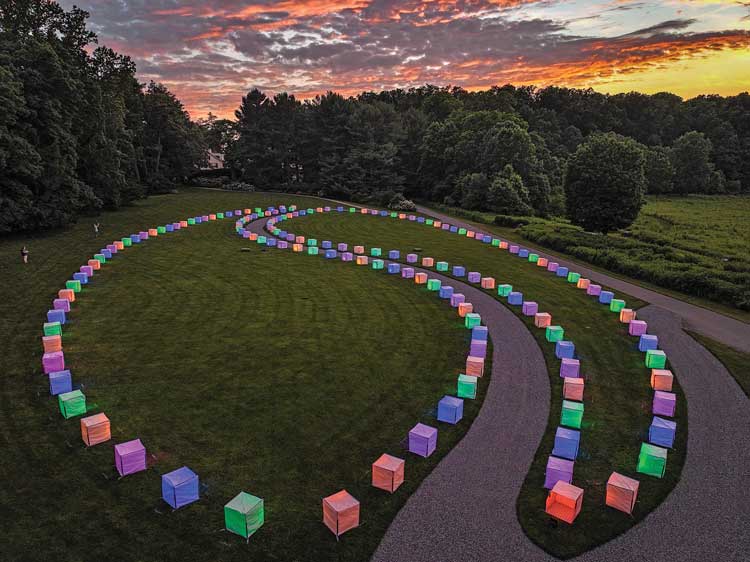
Bruce Munro, SOS Longwood Gardens, 2022. Gabion baskets, heavy duty sacks, speakers, sound track, 108 x 48 metres. Copyright © 2022 Bruce Munro. All rights reserved. Courtesy Longwood Gardens Carol Gross.
“The big change for me was that it went out to Longwood Gardens in Pennsylvania in 2012. They gave me an incredible exhibition, which included lots of different works. That was like winning the lottery, not monetary-wise, but in terms of opening new opportunities to make and show work at different venues across America and Europe.”
Jacquiline Creswell, the driving force behind Salisbury Cathedral ’s pioneering visual arts programme between 2009 and 2021, saw Munro’s Field of Light at the Eden Project and was immediately keen to bring his work to the 13th-century place of worship. Creswell is a great believer in visual art’s capacity to transcend the limitations of language and its potential to connect with people from different communities, faiths and backgrounds. “I’m not a religious person, but I do believe in goodness and good spirit,” says Munro, who has practiced Buddhist meditation since 1999, after finding solace in the Metta Bhavana, a prayer that he discovered while grieving the death of his father. “Salisbury Cathedral is an incredible place and Jacquiline is an amazing curator,” he enthuses, remembering how delighted he was when she invited him to create something there. It was the beginning of a long and fruitful relationship that saw him realise several ambitious light works at the cathedral between 2010 and 2020.
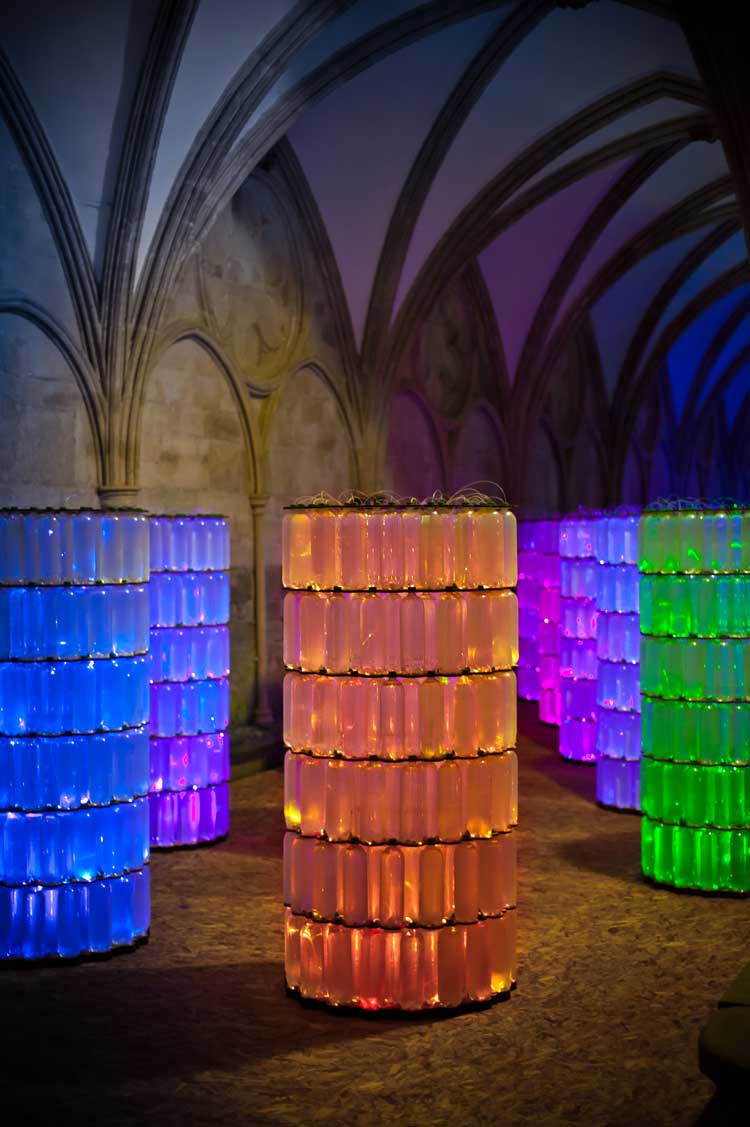
Bruce Munro. Water Towers, Salisbury Cathedral, 2010. Copyright © 2023 Bruce Munro. All rights reserved. Photo: Ash Mills.
The first work he exhibited at Salisbury was Water Towers (2010), an installation of 69 towers made from large transparent bottles filled with water and illuminated by optic fibres, which changed colour in response to music emanating from within them. Placed in the cathedral’s cloister, they appeared like enormous batteries of liquid light. “That was a dream project; they were like three-dimensional stained-glass windows that sang,” says Munro, who conceived the work for Longwood Gardens, as a tribute to Lyall Watson, a maverick thinker working at the margins of conventional science who believed that the Earth has a natural, inaudible pulse, resonating at a rate of 69 beats every 24 hours. He also authored Gifts of Unknown Things (1976), which Munro read as a young man. It features a girl with chromesthesia, a type of synesthesia that causes sounds to be perceived as colours. In the cathedral, Water Towers took on a spiritual dimension, resonating with the sacred architecture.
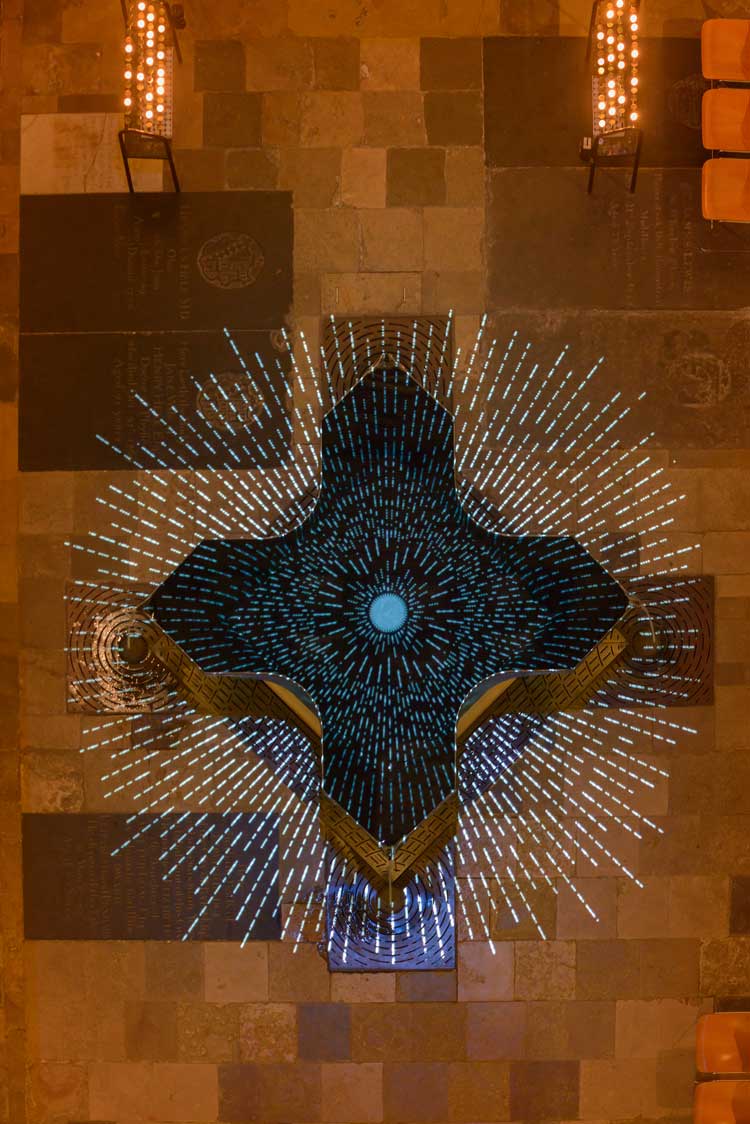
Bruce Munro. Star of Bethlehem, 2014. Courtesy of the Artist. Installation view Salisbury Cathedral. Photo: Ash Mills.
Christmas 2014 saw the installation of Munro’s Star of Bethlehem, a digital animation projected from above on to William Pye’s celebrated Living Water font. “Jacquiline invited me to create a work for the cathedral that celebrated the biblical Magi, the three wise men who followed the star to visit the infant Jesus,” he says. “I was very aware of how the star is often portrayed and I wanted to try to keep away from the commercialisation of Christmas and do something that was more in keeping with the liturgy.” At the time, he had been working on light and language pieces that used the dots and dashes of morse code to create graphic images. Realising that he could encode passages of text in this way, he created a literal and visual abstraction of the New Testament account of the Magi from Matthew 2:1-2, which appeared as scrolling pulses of light in the form of a star. The animation echoed the font’s flowing water, radiating from its centre, and pouring out over its edges. “The lovely thing was that some of the volunteer guides in the cathedral were ex-marines and were able to read the text as it moved across the font,” he says.
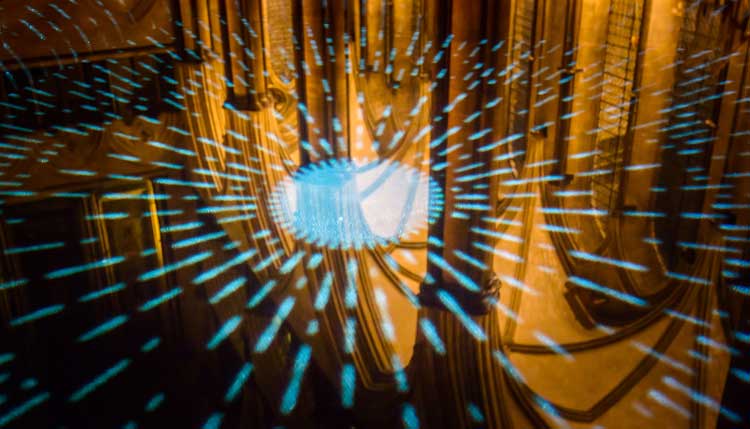
Bruce Munro. Star of Bethlehem, 2014. Courtesy of the Artist. Installation view Salisbury Cathedral. Photo: Ash Mills.
In 2021, as part of Chichester Cathedral’s Advent celebrations, Munro installed a carpet of 1,000 glowing orbs in the Paradise garden, a peaceful green space in the 600-year-old cloisters. Titled Field of Blooms, the installation riffed on the notion of sacred light shining in the darkness, a theme found in the opening verses of John’s Gospel and present in many Christmas services. Resonating with visitors to the cathedral, it created a mesmerising experience during the run-up to Christmas. The success of such works has led to Munro receiving countless invitations to install his fields of glowing orbs all over the world. “Field of Light has helped me fund a lot of other things,” he says, “but I do hold it back from going to every place that asks for it. You’ve got to be careful that you don’t overdo things.”
The most exciting invitation that Munro has ever received was to realise his dream of installing Field of Light at Uluru. “I did an interview with ABC in Alice Springs about my exhibition at the Holburne Museum and they discovered it was inspired by my trip to Uluru,” he says. “The journalist asked if I would like to do Field of Light in Uluru, and I said it would be a dream come true. Two days later, I got a phone call from this lovely man, Ray Stone, who worked for Voyages Indigenous Tourism Australia, an indigenous organisation connected with the Uluru people that manage tourism and resort facilities in the Northern Territory.” Stone had been looking for an added visitor attraction at Uluru and was excited by what he perceived as the spiritual aspect of Munro’s work, explaining that it was the spirituality of Uluru that made it the ideal location for his Field of Light.
Stone invited Munro to come out to Australia to discuss the possibility of realising his dream project at the Ayers Rock Resort. It was an irresistible proposition. “We were penniless at the time; you know, four kids, big mortgage,” he says. “But Ray was true to his word and, three years later, he phoned me up again to say that he’d found sponsors who were keen to be involved.” The location was carefully chosen to ensure the greatest visual impact. “The most important thing was how it sat in the landscape,” he says. “The area of ground that we used is about 300 metres in diameter, which seems large, but isn’t when compared to the vastness of the surrounding landscape. I chose that particular spot because I wanted to give the impression that the lights went over a horizon, so when you’re standing there, it appears to be extending over a ridge and on to another plane.”
The monumental installation of 52,000 fibre optic stems took Munro and his team about six weeks to complete, by which time the anticipation had built to fever pitch. “There was something quite surreal about it,” he says, recalling the moment he first saw the desert lit up by his work, the culmination of 24 years of dreaming, hoping and planning. “It was an incredible feeling.” On 31 March 2016, before it was publicly accessible, Field of Light was unveiled to the local Pitjantjatjara elders, the indigenous owners of the land. They had been supportive of the venture throughout and gave it a name in their language: Tili Wiru Tjuta Nyakutjaku, meaning “looking at lots of beautiful lights”.
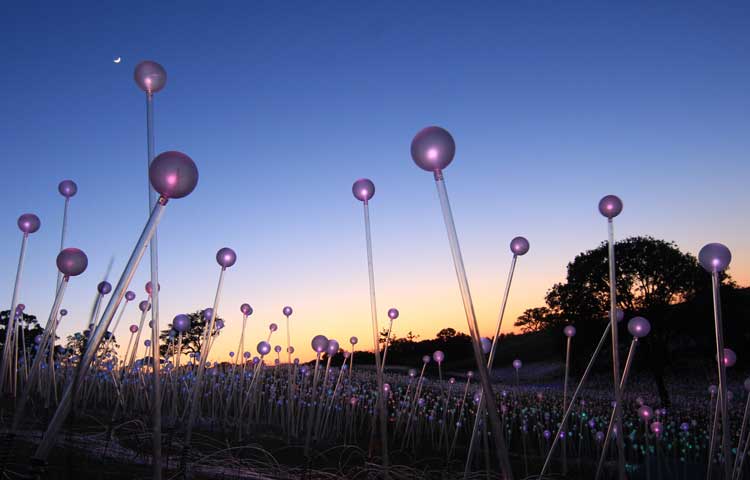
Bruce Munro, Field of Light, Sensorio, Paso Robles, California, USA, 2019. Mild steel, acrylic stems, glass spheres, fibre optics, light source, 26,500 sq metres. Photo: Serena Munro.
Field of Light has been exhibited in many places around the world. Besides Uluru, the only other permanent iteration of the installation is at Sensorio, Paso Robles, California, which opened in 2019. Initially, Munro installed 58,000 stems at the 156-hectare ranch, increasing this to 100,000 in 2022, making it the largest of his light installations to date. But while it has become a popular tourist attraction at these destinations, Field of Light is much more than an Instagrammable spectacle. As Gruber notes in her book, this and similar works engage with the tradition of the sublime in art, tapping into the sense of awe that comes from contemplating the grandeur of nature. “I’m not just making pretty things in fields,” says Munro, who is interested in harnessing the sense of connectedness that is felt when staring at a star-filled sky, or watching sunlight dancing on the ocean’s surface. “I want my installations to have an effect on people, to connect with the landscape, to bring people together and inspire a sense of wonder.”
• Light Field: The Art of Bruce Munro by Fiona Gruber is published by Lund Humphries, price £35.